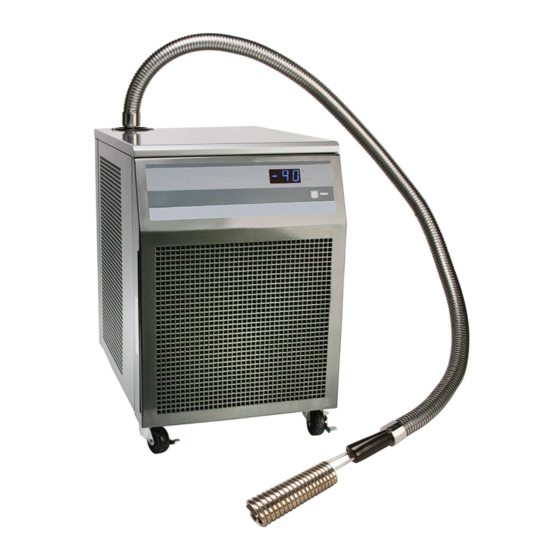Subscribe to Our Youtube Channel
Summary of Contents for Cole Parmer IP-400 Series
- Page 1 ® Cole-Parmer IP-400 Low-Temperature Immersion Chillers with Flexible Cold Finger Probe USER OPERATION MANUAL...
-
Page 2: Table Of Contents
Table of Contents Introduction................................2 General Information .............................. 2 General Safety Information ......................... 2 Safety Recommendations ..........................3 Unpacking Your Immersion Probe Cooler ..................... 3 Regulatory Compliance & Testing ........................ 4 Contents ..............................4 Controls & Components ............................5 Quick-Start ................................6 Installation &... -
Page 3: Introduction
Introduction Your Immersion Probe Cooler can be used to achieve low-temperature capability with non-refrigerated circulating baths or boost the cooling capacity of refrigerated circulators. It is also excellent for trapping and Dewar-type applications, making it an economical alternative to dry ice or liquid nitrogen. A 6-ft. (1.83 m) flexible hose allows convenient placement of the cooling probe. -
Page 4: Safety Recommendations
Safety Recommendations To prevent injury to personnel and/or damage to property, always follow your workplace’s safety procedures when operating this equipment. You should also comply with the following safety recommendations: WARNING: • Always connect the power cord on this unit to a grounded (3-prong) power outlet. Make certain that the outlet is the same voltage and frequency as your unit. -
Page 5: Regulatory Compliance & Testing
Regulatory Compliance & Testing cCSAus (120V, 60Hz units) UL 61010-1 (3rd Edition) - Safety Requirements for Electrical Equipment for Measurement, Control, and Laboratory Use - Part 1: General Requirements CAN/CSA-C22.2 No 61010-1-12 - Safety Requirements for Electrical Equipment for Measurement, Control, and Laboratory Use - Part 1: General Requirements Product meets CAN ICES-1/NMB-1 and FCC Part 15 This device complies with part 15 of the FCC rules. -
Page 6: Controls & Components
Controls & Components Temperature Display Power Key Air Filter Compartment Immersion Probe Assembly Rigid Coil Immersion Probe (3” rigid coil shown) IMPORTANT: The temperature display is for reference only. The actual temperature of the immersion probe will be colder than the displayed temperature. Cold Finger Immersion Probe Flexible Immersion Probe 1.75”... -
Page 7: Quick-Start
Quick-Start Position Immersion Probe Connect power. See Identification Label. Turn main power ON. Turn Standby power ON. Allow approximately 10 minutes for the system to begin the cooling process. Allow approximately 1 hour for system to reach -80°C (IP-80) or -90°C (IP-100). -
Page 8: Installation & Startup
Installation & Startup Your Immersion Probe Cooler is designed to be simple to set-up and install. No tools are required. General Site Requirements Locate the unit on a level surface, free from drafts and out of direct sunlight. Do not place it where there are corrosive fumes, excessive moisture, high room temperatures, or where excessive dust is present. -
Page 9: Electrical Power
Electrical Power WARNING: IMPORTANT INFORMATION FOR 100V APPLICATIONS On 100V 50Hz applications a step-up transformer IS NOT NEEDED and MUST NOT be used. On 100V 60Hz applications a step-up transformer MUST be used. WARNING: Make certain that the electrical outlet is the same voltage and frequency as your unit. The correct voltage and frequency for your unit are indicated on the Identification Label on the back panel. -
Page 10: Main Operational Display
Main Operational Display The actual temperature of the immersion probe is displayed in degrees C on the unit’s digital readout. Due to the location of the temperature sensor, this temperature is a few degrees warmer than the surface temperature of the immersion probe. -
Page 11: Routine Maintenance & Troubleshooting
Routine Maintenance & Troubleshooting Cleaning Exterior Surfaces Only mild detergents and water or an approved cleaner should be used on the painted surfaces of the Immersion Probe Cooler. Do not allow cleaning liquids or sprays to come in direct contact with the digital display. Cleaning the Air Filter To keep the refrigeration system operating at optimum cooling capacity, the front and back air vents and reusable filter should be kept free of dust and dirt. -
Page 12: Troubleshooting
Troubleshooting WARNING: Always turn the Power Switch / Circuit Breaker OFF and disconnect the electrical cord from the power source before servicing the unit. Problem Cause Corrective Action No power to unit Check that electrical cord is secure and plugged into an Unit does not run operating electrical outlet. -
Page 13: Technical Information
Technical Information Performance Specifications Model IP-80 IP-100 Temperature Range -80° to -40°C -100° to -60°C Temperature Set Point Fixed at -80°C Fixed at -100°C Readout Accuracy ±1.0°C Compressors Two nominal ½ HP low back pressure reciprocating compressors Cooling Probe Assembly 6 ft. -
Page 14: Equipment Disposal (Weee Directive)
Equipment Disposal (WEEE Directive) This equipment is marked with the crossed out wheeled bin symbol to indicate it is covered by the Waste Electrical and Electronic Equipment (WEEE) Directive and is not to be disposed of as unsorted municipal waste. Any products marked with this symbol must be collected separately, according to the regulatory guidelines in your area. -
Page 15: Warranty
Warranty The manufacturer agrees to correct for the original user of the product, either by repair (using new or refurbished parts), or at the manufacturer’s election, by replacement (with a new or refurbished product), any defects in material or workmanship which develop during the warranty period. The standard warranty is twenty-four (24) months after delivery of the product.



Need help?
Do you have a question about the IP-400 Series and is the answer not in the manual?
Questions and answers